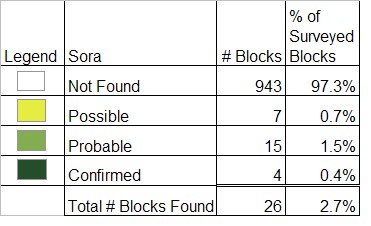Breeding Bird Atlases (BBA)
Find a Bird - BBA1
Breeding Bird Atlas 1 Species Accounts
Sora
Porzana carolina
Egg Dates
mid-May to early July
Number of Broods
one; may re-lay if first attempt fails.

The Sora is North America’s most common and widespread rail species. There is hardly a substantial marsh in the country that is not visited by this rail during its autumn migrations, when it is hunted widely as a game bird. In Massachusetts, it is best known as a transient in spring and fall and as a scarce and local breeding resident whose numbers are almost certainly declining as fewer and fewer extensive cattail marshes are available for breeding. Being more selective in its choice of breeding habitat than the Virginia Rail, the Sora is usually found nesting only in relatively extensive and unbroken stands of cattails, preferably with adjacent areas of open water. It seems to require marsh openings and water edges for foraging and generally seems far less tolerant of heavy shrub growth in its habitat than the Virginia Rail, whose overall requirements are otherwise similar. Rare as a breeder in western Massachusetts, the Sora has viable nesting populations in only a handful of marshes in the eastern part of the state.
Soras begin arriving in late April, usually a little after the first Virginia Rails are heard calling. The loquacity of both species is the best indication of their presence, and, because much of their vocalizing occurs at night, special effort is required to assess accurately the local status of either species.
The varied calls of the Sora include a sharp ker-wee given by the males and a rapidly descending whinny, which ends more slowly than it begins and has the terminal notes given on a uniform key. The whinny call is probably used by both sexes. Because Soras regularly give these calls on migration, it cannot be assumed that a calling Sora in appropriate habitat in mid-May is necessarily a breeding bird. This vocalizing by migrants possibly has given earlier Massachusetts ornithologists a false impression of the species’ abundance as a breeder in the state. As with a number of marsh birds, Soras produce a varied assortment of call notes when they have young in tow. Most typical of these is a sharp kip, somewhat reminiscent of the similar but more forceful note of the Common Moorhen.
Egg laying in Massachusetts takes place from mid-May to mid-June, with the clutches containing eight to twelve olive-buff eggs, sparsely blotched with chestnut red. The substantial nest, which is constructed of dead reeds, grasses, sedges, and weeds, is usually supported by grass stems and may be raised over the water or located on a tussock at the water’s edge. Incubation is by both sexes and lasts from 16 to 20 days. When the black, downy chicks hatch, they are precocial and are ready to leave the nest within a day or two. The family remains together for several weeks, and the young are able to fly in approximately a month. Adults tending from four to six chicks have been recorded in Massachusetts from June 24 to July 1, and a juvenile was seen accompanying adults on July 7 (BOEM).
By early fall, marshes and river meadows, especially ones where Wild Rice grows in abundance, sometimes throng with migrant Soras. There, in the company of Bobolinks and other blackbirds, they harvest the plentiful seeds of the marshland grain crop. Each frost encourages Soras southward, and often during migration they can be found in salt marshes or dry fields far from their more typical summer haunts. Most have departed by November, and, unlike the hardier Virginia Rail, this species is relatively rare as a wintering bird in Massachusetts, moving instead to the southern United States, Mexico, Central America, the West Indies, and northern South America.
Map Legend and Data Summary
Atlas 1 data collected from 1975-1979


Note: rare to locally uncommon in freshwater cattail marshes
Wayne R. Petersen



